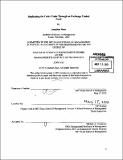| dc.contributor.advisor | S.P. Kothari. | en_US |
| dc.contributor.author | Shan, Jonathan (Jonathan W.) | en_US |
| dc.contributor.other | Sloan School of Management. | en_US |
| dc.date.accessioned | 2013-09-12T19:19:07Z | |
| dc.date.available | 2013-09-12T19:19:07Z | |
| dc.date.copyright | 2013 | en_US |
| dc.date.issued | 2013 | en_US |
| dc.identifier.uri | http://hdl.handle.net/1721.1/80680 | |
| dc.description | Thesis (S.M.)--Massachusetts Institute of Technology, Sloan School of Management, 2013. | en_US |
| dc.description | Cataloged from PDF version of thesis. | en_US |
| dc.description | Includes bibliographical references (p. 45-49). | en_US |
| dc.description.abstract | There is an overarching belief that the carry trade is a simple investment strategy based on the popular mantra of buying low and selling high. However, in reality, there are several factors that need to be taken into consideration when devising a carry trade strategy. These hardships are further complicated by the number of options available in such a strategy. The main objective of my thesis is to implement this popular hedge fund strategy through the structure of an exchange traded fund. The interest rate spread between two different currencies should be an expectation of future exchange rates, however, empirically, this belief does not hold true. The carry trade takes advantage of this violation of uncovered interest rate parity and I will show that a specific implementation of the carry trade yielded positive returns on a historical basis. I believe it is essential to understand the basics of the carry trade. I will discuss the mechanics and highlight the inherent advantages and risk factors in making such an investment. I will then discuss the current landscape and what financial products are available to investors who want to take advantage of the carry trade - from hedge funds to exchange traded notes and exchange traded funds. Next, I will discuss how one goes about launching an exchange traded fund and the various considerations that need to be made by someone undertaking such an endeavor. Finally, I will try and establish demand for a carry trade exchange traded fund in the retirement market and investigate the hurdles for such a product. | en_US |
| dc.description.statementofresponsibility | by Jonathan Shan. | en_US |
| dc.format.extent | 49 p. | en_US |
| dc.language.iso | eng | en_US |
| dc.publisher | Massachusetts Institute of Technology | en_US |
| dc.rights | M.I.T. theses are protected by
copyright. They may be viewed from this source for any purpose, but
reproduction or distribution in any format is prohibited without written
permission. See provided URL for inquiries about permission. | en_US |
| dc.rights.uri | http://dspace.mit.edu/handle/1721.1/7582 | en_US |
| dc.subject | Sloan School of Management. | en_US |
| dc.title | Replicating the carry trade through an exchange traded fund | en_US |
| dc.type | Thesis | en_US |
| dc.description.degree | S.M. | en_US |
| dc.contributor.department | Sloan School of Management | |
| dc.identifier.oclc | 857768448 | en_US |
